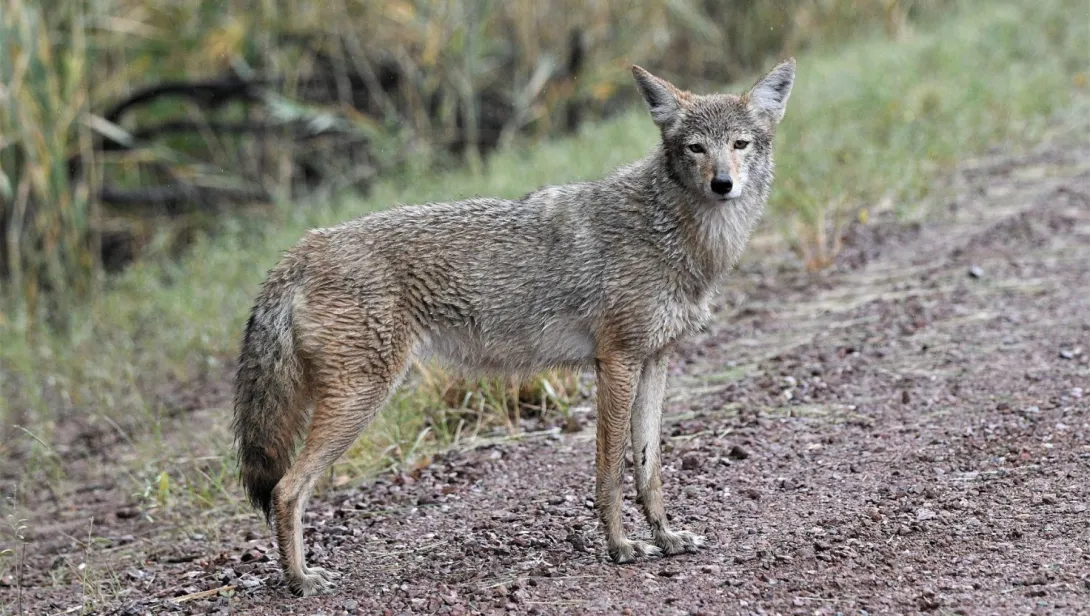Skip to main content
Introduction
- Coyotes are medium-sized canines scientifically known as Canis latrans.
- They are highly adaptable and are found throughout North and Central America.
- Coyotes are known for their intelligence, resourcefulness, and vocalizations, including their iconic howls.
Physical Characteristics
- Coyotes have a slender, agile body, with males weighing between 20 to 50 pounds (9 to 23 kg) and females slightly smaller.
- Their coat color varies from gray, brown, to reddish, often with a mix of white and black markings.
- Coyotes have pointed ears, a narrow muzzle, and a bushy tail.
- They are fast runners, capable of reaching speeds up to 40 mph (64 km/h).
Habitat and Distribution
- Coyotes are found in a wide range of habitats, including forests, deserts, grasslands, and urban areas.
- They are native to North America but have expanded their range to Central America and even parts of Canada.
- Coyotes are highly adaptable and can thrive in both rural and urban environments.
Diet and Hunting
- Coyotes are omnivorous and have a varied diet that includes small mammals, birds, insects, fruits, and carrion.
- They are opportunistic feeders and will eat almost anything they can find, including human garbage.
- Coyotes are solitary hunters but may hunt in pairs or small groups for larger prey.
- They are nocturnal, being most active during the night and early morning.
Behavior and Communication
- Coyotes are solitary animals but may form small family groups or packs.
- They communicate through vocalizations such as howls, yips, barks, and growls, as well as through body language.
- Coyotes are territorial and mark their territory with scent markings and vocalizations.
- They are highly intelligent and capable of solving complex problems.
Reproduction and Lifespan
- Female coyotes give birth to 4 to 7 pups after a gestation period of about 60 to 63 days.
- Coyote pups are born blind and rely on their mother and the pack for protection and nourishment.
- Pups stay with the family group for 6 to 9 months before becoming independent.
- Coyotes have a lifespan of 10 to 14 years in the wild and up to 20 years in captivity.
Conservation Status
- Coyotes are classified as Least Concern on the IUCN Red List, with stable populations.
- They are highly adaptable and have expanded their range despite human encroachment.
- Coyotes are often seen as pests due to their predation on livestock and pets.
Unique Adaptations
- Coyotes have excellent hearing and sense of smell, which aid in hunting and communication.
- Their slender body and long legs allow them to travel long distances and navigate various terrains.
- Coyotes are highly adaptable and can thrive in both rural and urban environments.
- They are nocturnal, which helps them avoid human activity and other predators.
Cultural Significance
- Coyotes are revered in many Native American cultures as symbols of trickery, intelligence, and adaptability.
- They are featured in mythology, literature, and art across North America.
- In some cultures, coyotes are considered spiritual guides and teachers.
Fun Facts
- Coyotes can run at speeds of up to 40 mph (64 km/h).
- They are highly vocal animals, with a wide range of sounds used for communication.
- Coyotes can travel up to 10 miles (16 km) in a single night in search of food.
- They are keystone species, playing a crucial role in maintaining ecosystem balance.
- Coyotes are highly intelligent and capable of solving complex problems.
- They are ancestors of domestic dogs, with whom they share many behavioral traits.
Threats to Coyotes
- Human-wildlife conflict often results in coyotes being killed by farmers protecting livestock and pets.
- Hunting and trapping for their fur and as a means of predator control are significant causes of their decline.
- Habitat loss due to urbanization and agriculture is a major threat to coyotes.
- Climate change is altering their habitats, making it harder for them to find prey.
Conservation Efforts
- Protected areas and wildlife reserves have been established to safeguard coyote habitats.
- Legal protection and stricter wildlife protection laws have helped reduce illegal hunting.
- Community-based conservation programs work to reduce human-wildlife conflict.
- Global awareness campaigns highlight the importance of coyote conservation and encourage public support.
